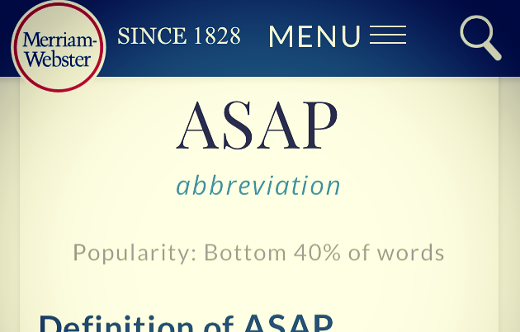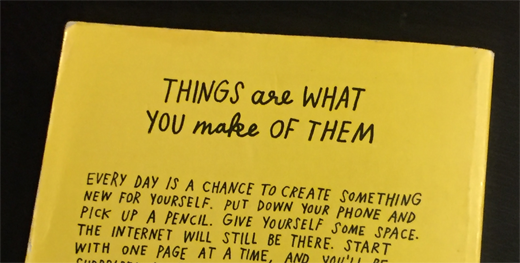Thriving In A Culture of ASAP
When you see “ASAP” in an email or text, do you cringe? Sadly most of us do – I do – as the acronym, which is made up of pleasant words, has ended up becoming a harsh term.
Looking up the definition of ASAP in the dictionary you see it stands for “as soon as possible” which is, as I said, pleasant. But thinking back to the cringe-causing event (or more likely events) that come to mind when you read the opening of this post, do you think the person typing ASAP really meant “as soon as possible?”
Hell no I can hear you say! Rather than asking you to do something as soon as it is possible for you to do so, aren’t they really asking, “drop all you are doing and respond to this right this fucking second!” Let’s be honest, this is what should be listed in the dictionary as the true definition of what ASAP means, and not just the words behind the acronym.
The Culture of ASAP
Most organizations have a culture of ASAP. In this hyper-connected world where any information can be had in seconds, we have a heightened expectation that seems to come with a narrowing window as time goes on.
Note I say “any” information and not the “right” information or even accurate information, or any other qualifying adjectives that requires strategic thinking. This has no place in the culture of ASAP, as everything is being responded to fast and furiously. Even if the answers or responses have already been prepared and presentation in reports or dashboards, the person slinging ASAP around has no time for these tools and want the answers from you and right now, though ironically they may be the owner of said reports and dashboards.
Succeeding Under ASAP
It goes without saying that to get beyond a culture of ASAP takes leadership. Part of that leadership is in communications – sharing expectations of greater foals and what may be asked of a team. As well, the team is given time to ideate and strategize the big picture down to their area of expertise and can thus be proactive in using information sources or channels.
In the absence of that leadership, there is still the ability to make gains and efficiencies yourself to make your life easier. Simply documenting ASAP requests is a great start, by recording overall what is being asked, looking for trends, and comparing it to what you are doing now. Incremental improvements to processes or reporting can be made as a result of this analysis. As requests come in, make sure you are clear as to what is being asked and – if appropriate – why it is being needed. The “why” can influence “what” is created. These latter steps are things I do on a routine basis to make both the collection of data and reporting of information much more efficient.
Deconstructing ASAP
Priorities in business change frequently and requests can come in that need to take top priority. With some analysis and a small series of successful changes, dealing with ASAP can be made much less harsh, as it is likely to not go away altogether.
This is from The Hot Iron, a journal on business and technology by Mike Maddaloni.
Did you enjoy this? Subscribe to The Hot Iron by RSS/XML feed or Read by Email.
Business • Strategize • Thrive • (2) Comments • Permalink
Stir The Soul
Congratulations to the Chicago Cubs for winning the 2016 World Series, ending a 108-year championship drought! As a fan of the Boston Red Sox, who ended their own 86-year drought in 2004 – ironically just after I moved from Boston to Chicago – there has always been a kindred spirit between the teams, and I am glad to see them win it all.
As I watched the final out of the game – at home, after leaving the pub where several families and their kids stayed far too late on a school night – I heard the jubilation in the neighborhood of literal screams and shouts. I was happy for the team and Chicago, especially for friends and colleagues – loyal fans who have been waiting for “next year” to finally come.
Though I was happy, I can’t say I was emotional about it. Granted, it was after midnight, but the strong feeling I have experienced when others of my teams – the Red Sox, New England Patriots and even my adopted Chicago Blackhawks – won their championship titles was just not there.
That is, until I saw this. Click on the embedded video below to play it, or click this link to watch the video on YouTube.
The video is from Budweiser and was released on the morning after the game. It is an extremely creative piece, combining modern video of Chicago and its fans watching the game and vintage video and audio of the late legendary Cubs announcer Harry Caray, edited to match the final out of the game. It’s as if Caray was alive today, making the call himself.
This got to me. And I finally felt the emotion I would expect to feel, as I have felt in the past when not only a team of mine won, but for other exciting events in my life.
Why it got to me is not surprising. As someone who grew up in an age before ESPN (interestingly, ESPN founder Bill Rasmussen was a local sports reporter where I grew up before he started the cable network) and the ability to see games all the time, we may have gotten 1 or 2 games a week on TV, but radio was where all games were broadcast. In those days, play-by-play announcers had a much different style than they do today; they were much more conversational, and in the absence of today’s computer-generated bombardment of stats, filled gaps with anecdotes that gave you a broader sense of what it was like to be in the ballpark.
Where I knew about Harry Caray and his antics in Chicago, for me it was Ken Coleman who was the play-by-play announcer for the Red Sox. An older gentleman, his mellow voice was a contrast to today’s announcers, and it was like listening to old Uncle Ken telling the story of today’s game.
To say they don’t make them like that anymore is more than cliché. Where Coleman, as Caray, did not see a World Series for their teams in their lifetimes, it was nice that this tribute to Caray was crafted.
(Edited 7/9/2017 and 7/30/2018 - changed link and embed from the original video to an alternate one as it was no longer available.)
This is from The Hot Iron, a journal on business and technology by Mike Maddaloni.
Did you enjoy this? Subscribe to The Hot Iron by RSS/XML feed or Read by Email.
Announcements • Blogging • Diversions • Thrive • (0) Comments • Permalink
I’m A Teacher
Who would’ve thought a wedding reception in Indianapolis would be where I’d realized something that has helped shape the path I’ve taken with my career?
It was following the wedding of my friends Jen and Bill at their reception where it happened. Bill was making a speech, and though I don’t remember it verbatim (sorry, Bill!) he began talking about teachers, as he is one himself. Then he asked everyone in the room who was a teacher to stand up.
And I stood up.
Not only did I stand up, but nobody snickered or asked me to sit down either. This is when I first realized I am a teacher.
Define Teacher
When I lookup the definition of the word teacher in my favorite book of words, it reads, “a person or thing that teaches something; especially: a person whose job is to teach students about certain subjects.” This is why I have never thought of myself as a teacher, namely as I have never had a title with the word “teacher” in it before. My job titles have had “consultant,” “manager” and “president” and other business titles – but never teacher.
As I look at my career present-day and past, I have always been teaching in some capacity. There is teaching in the formal sense, were I have developed training and offered classes in the US and internationally on Web application and their underlying technology, I have also developed Web portals to host and deliver these materials. Then there’s teaching in a more advisory role, where I am consulting with people on business decisions and how to apply technology to help solve them. In some cases I am coming in with the answer after strategizing on it, other times I am troubleshooting in real-time to come up with a solution.
In the above cases, teaching is pervasive. I’m not simply saying to a client, “do X,” rather I am explaining what “X” is, answering their questions on “X,” informing them about “y” and other letters of the alphabet, and ensuring they have all the information they need to make an informed decision.
Educating vs. Selling
Some of you reading this may be saying, “yea, but aren’t really selling something to people in these cases, not teaching them?” Part of that answer is certainly yes, but when someone or some corporation is shelling out a lot of money, they need to understand the why, not only from a pure dollars-and-cents point-of-view, but with regards to how to best leverage and use it among other aspects. Teaching of course is an important role for sales and account people too, not just for the technology strategist like myself.
This is of course not to say that everybody is a teacher (I don’t recall everybody standing up at that wedding reception). Many don’t like to or want to teach. Each to themselves, but for myself I have always found this as a very rewarding aspect of what I do, past and present. Not to mention making my job easier by working with a well-informed client.
Deconstructing Being a Teacher
There are many more people out there who are teachers than realize it. We always envision a teacher as someone heading a classroom in elementary or high school, and has the word “teacher” in their title. I am not saying I am a replacement for them, rather someone complimenting their contributions to society with my own.
And you can give me an apple anytime!
This is from The Hot Iron, a journal on business and technology by Mike Maddaloni.
Did you enjoy this? Subscribe to The Hot Iron by RSS/XML feed or Read by Email.
Business • Technology • Thrive • (1) Comments • Permalink
About My Deconstructions
When I started writing here at The Hot Iron, the name came from the expression, “strike while the iron is hot.” Though my entry into the world of blogging could be considered more functional than creative, taking burning topics – whether business, technology or personal – and boiling them down was far from anything new to me.
Much thought has gone into the direction of my blog lately, which is one aspect of the thought into my greater self. As I have considered the focus on what I write, I have also focused on how I write, namely in the approach I take with covering a topic. The product of this quest is what I am calling My Deconstructions.
What is a deconstruction? As I write here and elsewhere, I will strive to take my analysis and reporting on a topic and conclude it by breaking it down into essential points and conclusions. In some regards it will be similar to my book takeaways; rather than rating a book I share what I gained from the time spent reading it. In some cases it is a summary, and in others I look back on something I took from it and am surprised I came up with it! The deconstruction may be takeaways, action items, next steps, essential components, revelations or something else I haven't thought of a category for.
Like anything, I have already started writing these and will see how it evolves. As a reader, whether your first time or as a long-time one (and I know there's a few of you out there), I welcome your thoughts and feedback as this new approach appears in my future posts.
Deconstructing Deconstructions
Why shouldn't what I write about deconstructions have one itself? As time is always of the essence, taking the time to make or reiterate the main points from something is always useful to whoever is consuming it. It also helps the reader understand your main points, as you never want to assume someone has gleaned them from reading your work. In the end the reader – you – will say if these deconstructions are helpful, and please let me know in the comments to this post either way.
This is from The Hot Iron, a journal on business and technology by Mike Maddaloni.
Did you enjoy this? Subscribe to The Hot Iron by RSS/XML feed or Read by Email.
Announcements • Business • Strategize • (0) Comments • Permalink
My Takeaways So Far From The Book 1 Page At A Time
A consequence of being in a routine is that our entire body can be consumed by it. Where things like repetitive strain injuries or simply being sore from sitting on our butt for a long time are obvious, what isn’t as apparent is the impact on our brain.
If you don’t believe me, here’s an example – you are buzzing along in what you do all day and someone comes along and asks you a question, and all you can do is stare back dumbfounded. They may have well as used a Sharpie and wrote it on a pool noodle and hit you with it. Call it brain fatigue, but does it show a sign your brain needs some exercising?
When I saw the book 1 Page at a Time – A Daily Creative Companion by Adam J. Kurtz sitting on the shelf at Judy Maxwell Home in Chicago, I couldn’t help but pick it up. (If you don’t know about this store, think Spencer Gifts with an old-world flair and a sharper edge; it’s also owned by actress Joan Cusack, so that adds to its eccentricity) It only took me flipping through the first few pages and I was sold. It is an adult workbook, with a page a day dedicated to a brief creative exercise to do in the book.
Each page presents a unique activity, from making a list to drawing a picture to whatever. Some are quick and easy, some require actual thought. As it’s a page a day, and I started late last year, I am not done yet – thus the “so far” in the title – but I have enjoyed every exercise so far.
Though I have much to go, I feel my takeaways from 1 Page at a Time will endure and be reinforced as I go through it.
Think Different – Borrowing from the infamous Apple tag line, this book does just that. It asks you to do things you most likely don’t normally do on a regular basis as part of your job or even for fun.
Challenge Yourself – As some of the activities have required me to sit back and ponder before putting pen to page, it’s been extremely helpful to have a challenge that is outside of my normal work and life challenges, which tend to be more technical, business and child-focused.
Draw – When was the last time you drew a picture? For the fun of it? This is probably why adult coloring books are all the rage these days. Where many of you reading this may not consider yourself an artist, the drawing I am talking about is not about being an artist. Rather, it is about expressing something with visualization.
On occasion a day or 2 go by when I don’t do a page a day, but then I catch up on them. I tend to do them in page sequential order, but there is no reason you can’t flip around and choose one at random. I never read ahead, as I like to approach these with some spontaneity.
I highly recommend getting a copy of 1 Page at a Time, or get 2 – 1 for yourself and 1 for a friend. If you have it and are using it, I’d love to hear what you think about it in the comments to this post.
This is from The Hot Iron, a journal on business and technology by Mike Maddaloni.
Did you enjoy this? Subscribe to The Hot Iron by RSS/XML feed or Read by Email.
Book Take-Aways • Business • Strategize • Thrive • (3) Comments • Permalink








